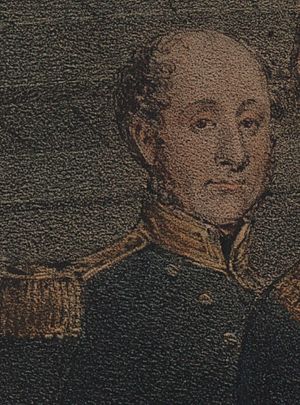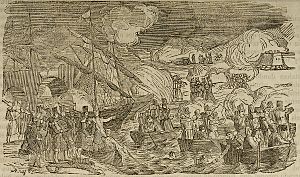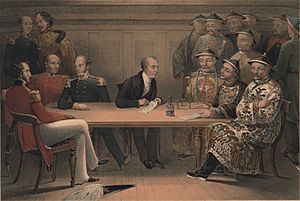Thomas Maitland, 11th Earl of Lauderdale facts for kids
Quick facts for kids
The Earl of Lauderdale
|
|
|---|---|

Thomas Maitland
|
|
| Born | 3 February 1803 Frankfort, County Cork |
| Died | 1 September 1878 (aged 75) |
| Allegiance | United Kingdom |
| Service/ |
|
| Years of service | 1816–1873 |
| Rank | Admiral of the Fleet |
| Commands held | HMS Sparrowhawk HMS Tweed HMS Wellesley Pacific Station |
| Battles/wars | Greek War of Independence Irish and German Mercenary Soldiers' Revolt First Carlist War First Opium War |
| Awards | Knight Grand Cross of the Order of the Bath |
Thomas Maitland (born February 3, 1803, died September 1, 1878) was a very important officer in the Royal Navy. He eventually became an Admiral of the Fleet. This is the highest rank in the British Navy. He was also known as the 11th Earl of Lauderdale.
As a young officer, he helped block the port of Algiers in 1824. This was during the Greek War of Independence. He also helped protect the Emperor of Brazil, Pedro I, during a revolt. Later, he fought in the First Carlist War to defend the port of Bilbao in Spain.
Maitland also played a big part in the First Opium War. He led a naval group in battles like the Battle of Canton. He later advised the government that building strong ships was more important than building forts. He then became the Commander-in-Chief of the Pacific Station.
Contents

Thomas Maitland was the only son of General William Maitland. He joined the navy when he was 13 years old, in 1816. He quickly moved up the ranks. In 1823, he became a lieutenant. He served on a ship called HMS Euryalus in the Mediterranean Sea.
In July 1824, his ship helped the Greek revolutionaries. They were trying to block the port of Algiers during the Greek War of Independence. This was one of his first big actions.
In 1827, he was promoted to commander. He was on HMS Ganges. This ship helped protect Pedro I, the Emperor of Brazil. They landed a special naval group to help him during a revolt in 1828.
Maitland then commanded HMS Sparrowhawk in 1832. He brought back a lot of treasure to Britain. This included over half a million Spanish dollars. He also brought back cochineal, a natural red dye.
In 1836, he commanded HMS Tweed. He took part in the Battle of Luchana. This battle helped defend the port of Bilbao in Spain. It was during the First Carlist War. For his bravery, he received an award from Spain.
Fighting in the Opium War

Maitland became a captain in 1837. He was given command of HMS Wellesley. This ship was the main ship for the Commander-in-Chief in the East Indies and China.
He saw action in the Persian Gulf in 1839. Then, he fought in the First Opium War against China. He was involved in many important battles. These included the Capture of Chusan in 1840 and the Battle of the Bogue in 1841.
He also led the first naval group during the Battle of Canton in 1841. For his actions, he received another award, becoming a Commander of the Order of the Bath. He continued to fight in battles like the Battle of Amoy and the second Capture of Chusan. He also fought in the Battle of Ningpo and the Battle of Chinkiang. These battles helped lead to the Treaty of Nanking, which ended the war in 1842.
After the Opium War, Maitland commanded several other important ships. These included HMS America, HMS San Josef, and HMS Impregnable. He also commanded HMS Agamemnon and HMS Victory. Later, he led the Gunnery School, HMS Excellent.
In 1857, Maitland was promoted to rear-admiral. He gave advice to a special government group in 1859. He believed that building powerful ships was more important than building strong forts.
From 1860 to 1862, he was the Commander-in-Chief of the Pacific Station. This was a very important role. In 1863, he inherited the title of Earl of Lauderdale. This meant he became a peer.
He continued to rise in rank. In 1863, he became a vice admiral. In 1865, he was made a Knight Commander of the Order of the Bath. He became a full admiral in 1868.
In 1873, he retired from the navy. He was then given the highest honor, becoming a Knight Grand Cross of the Order of the Bath. On December 27, 1877, he reached the highest rank possible: Admiral of the Fleet. He passed away at his home, Thirlestane Castle, in September 1878.
His Family
Thomas Maitland married Amelia Young in 1828. They had one son, Thomas Mordaunt, who sadly died young. They also had three daughters: Isabel Anne, Lady Alice Charlotte, and Lady Mary Jane. His daughter, Mary Jane, married Reginald Brabazon, who was the twelfth Earl of Meath.
After Thomas Maitland passed away, his cousin, Charles Barclay-Maitland, became the next Earl of Lauderdale.
His Legacy
A road in London, called Lauderdale Road in Maida Vale, is named after him.
Images for kids



